My older brother, who lost his mother-in-law 10 days before our mother died, quipped: “When your kids grow up, they say the couple should find something to do together, but double mourning is ridiculous.”
These 73 weeks of mourning overlapped with the 500-plus days of corona crisis (and counting…). With the Angel of Death and Demons of Destruction hovering, saying kaddish (the mourners’ prayer) three times daily introduced us to two extraordinary communities – a lovely daily Zoom minyan and an amazing Ashke-sfard, Sabr-olim neighborhood minyan every Sabbath. Beyond staying social – and thus sane - throughout the lockdowns, and making new friends for life, I appreciated the gift of life Judaism’s long-mourning approach provides.
It’s easy to caricature Judaism as a death cult, with Jews so traumatized by Jew-hatred and martyrdom that mourning often replaces praying. I remember, as a kid, the surge in synagogue arrivals for Yizkor, the memorial service, or the suddenly legalistic rigor with which some of the loosest Jews approached their parents’ deaths. But those who only do Jewish in death miss a lovely road map for life. Just as the kaddish memorial prayer doesn’t mention death, Judaism’s approach to death affirms life.
It starts with Genesis, when God structures time by creating during six days, then resting on the seventh. Inventing Shabbat, distinguishing rest-time from work-time, sacred time from secular time, was what Thomas Cahill called one “gift of the Jews.”
That power to shape time informs the mourning choreography. It helps you grieve while easing you out gradually – from seven days to 30 days to 11 months to the new normal. This extended, punctuated mourning allowed me to remember and honor these two precious people while transitioning from the burial’s rawness to daily life’s blessed distractedness.
Still, knowing that, till the day I die, I will mark my mother’s loss on the seventh of Adar and my father-in-law’s loss on the 21st of Av, and periodically throughout the Jewish year, catapults me far beyond the moment into Jewish identitime. It roots me in daily life and eternal life, while launching me into grander arcs of memory and meaning.
AMERICANS TODAY see the contrast between the underclass, living in the moment, and the upper middle class, living in its mission. Those living in the moment give birth too young and expect to die too young, too. Indulging the moment may sometimes seem fun, but it telegraphs despair: you drift because nothing you do can change your destiny.
Those who escape the ghetto embrace the upper-middle-class notion that working hard and sacrificing long generate future payoffs. It’s Aesop, American-style: partying grasshoppers mock the industrious ants, only to starve at wintertime when the ants eat what they saved.
Still, the corona crisis exposed the weak underbelly of only living in your mission. When conditions change, when an invisible plague menaces you despite your fancy degrees, if you only are what you do, you’re lost. You need to be resilient enough to see a bigger picture. You must be connected enough beyond yourself and your careerism to feel part of a bigger story.
Unfortunately, long before corona, too many Americans, from the most comfortable homes, could stick it out for a future payoff but lack the anchoring, a core identity, broad perspective, to stabilize themselves when crisis strikes.
That, ultimately, is the gift of living in Zionist time and Jewish time. You are never alone – always in community, in conversation with others beyond your immediate circle, including with others no longer living.
The Jewish mourning process solidifies that dialogue with the dead, the never-ending interaction with the dearly departed values, traditions, ideals. It cements your inheritance from that person, making it ethereal and eternal, not about money but memory, not about now but forever.
Kaddish, Yizkor, all these props for grieving, connect us to our not-that-lost loved ones, giving us a voice to affirm our connection to them and to more eternal processes.
Today, some of us may live just in Israel time, focusing on our 74-year-old miracle. Even that’s enough to pull us out of modernity’s selfish (and often self-pitying) vortex. But historic-minded Zionists, from Left to Right, and tradition-positive Jews incorporate our moment into a broader, sweeping, 3,900-year-old story, which propels us, our relatives, our role models, to a higher plane, lasting ideals, eternal time.
Different props do that for others in different communities, too. These, however, are mine, ours – and we’re pretty good at this, having mastered it over millennia.
In finishing our formal mourning, we continue integrating, weaving our parents’ legacies into our lives. As humans, as Jews, we live in the moment and in the mission, as well as in the lifetime and in the eternal. That’s what my Zionism provides: it connects me to community, the “who we are,” and to history, “the who we were.” That’s what my Judaism offers: it connects me to the forever, “the who we want to be,” and to the eternal, “that which is beyond us.”
That’s what my 500 days of mourning strengthened. That’s what I teach when I teach about Judaism and Zionism – not just the “what to do” in synagogue, not just the “what to say” about Israel, but the “what it all means” to each of us, in our own way, and to so many of us as one community, one eternal people, never lost, never truly abandoned, never really bereft, because we’re never alone.
The writer is a distinguished scholar of North American history at McGill University and the author of nine books on American history and three on Zionism. His book Never Alone: Prison, Politics and My People, coauthored with Natan Sharansky, was just published by PublicAffairs of Hachette.
